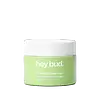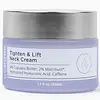What's inside
What's inside
 Key Ingredients
Key Ingredients

 Benefits
Benefits

 Concerns
Concerns

 Ingredients Side-by-side
Ingredients Side-by-side

Water
Skin ConditioningCaprylic/Capric Triglyceride
MaskingSorbitan Olivate
EmulsifyingPropanediol
SolventCetearyl Olivate
Prunus Amygdalus Dulcis Oil
Skin ConditioningAloe Barbadensis Leaf Juice
Skin ConditioningButyrospermum Parkii Butter
Skin ConditioningEthylhexyl Olivate
Skin ConditioningSclerocarya Birrea Seed Oil
HumectantCannabis Sativa Seed Oil
EmollientSaccharide Isomerate
HumectantCamellia Sinensis Leaf Extract
AntimicrobialGlycine Soja Oil
EmollientTocopherol
AntioxidantGlycerin
HumectantPhenoxyethanol
PreservativeVitis Vinifera Seed Oil
EmollientHydroxyethyl Acrylate/Sodium Acryloyldimethyl Taurate Copolymer
Emulsion StabilisingEthylhexylglycerin
Skin ConditioningSodium Benzoate
MaskingCitric Acid
BufferingSodium Citrate
BufferingWater, Caprylic/Capric Triglyceride, Sorbitan Olivate, Propanediol, Cetearyl Olivate, Prunus Amygdalus Dulcis Oil, Aloe Barbadensis Leaf Juice, Butyrospermum Parkii Butter, Ethylhexyl Olivate, Sclerocarya Birrea Seed Oil, Cannabis Sativa Seed Oil, Saccharide Isomerate, Camellia Sinensis Leaf Extract, Glycine Soja Oil, Tocopherol, Glycerin, Phenoxyethanol, Vitis Vinifera Seed Oil, Hydroxyethyl Acrylate/Sodium Acryloyldimethyl Taurate Copolymer, Ethylhexylglycerin, Sodium Benzoate, Citric Acid, Sodium Citrate
Water
Skin ConditioningAloe Barbadensis Leaf Juice
Skin ConditioningDiisooctyl Succinate
EmollientTheobroma Grandiflorum Seed Butter
Skin ConditioningDiisopropyl Dimer Dilinoleate
EmollientPropanediol
SolventLimnanthes Alba Seed Oil
Skin ConditioningHydrogenated Ethylhexyl Olivate
EmollientHydrogenated Olive Oil Unsaponifiables
EmollientCaprylic/Capric Triglyceride
MaskingSimmondsia Chinensis Seed Oil
EmollientCetearyl Olivate
Sorbitan Olivate
EmulsifyingCetearyl Alcohol
EmollientCetyl Palmitate
EmollientSorbitan Palmitate
EmulsifyingSorbitan Oleate
EmulsifyingHydrolyzed Hyaluronic Acid
HumectantPiperonyl Glucoside
Skin ProtectingGlycerin
HumectantLecithin
EmollientCaffeine
Skin ConditioningPalmitoyl Carnitine
Skin ConditioningHydrolyzed Plukenetia Volubilis Seed Extract
Emulsion StabilisingGeranium Maculatum Extract
TonicEquisetum Arvense Extract
AstringentHamamelis Virginiana Bark/Leaf/Twig Extract
Skin ConditioningTaraxacum Officinale Extract
Skin ConditioningPropolis Extract
Skin ConditioningCamellia Sinensis Leaf Extract
AntimicrobialCentella Asiatica Extract
CleansingOryza Sativa Bran Extract
Skin ConditioningRosmarinus Officinalis Leaf Extract
AntimicrobialHelianthus Annuus Seed Extract
Skin ConditioningTocopherol
AntioxidantSimmondsia Chinensis Seed Extract
AbrasiveTamarindus Indica Seed Polysaccharide
Skin ConditioningLavandula Angustifolia Oil
MaskingCitric Acid
BufferingSclerotium Gum
Emulsion StabilisingPotassium Sorbate
PreservativeSodium Benzoate
Masking1,2-Hexanediol
Skin ConditioningCaprylyl Glycol
EmollientLonicera Caprifolium Flower Extract
PerfumingLonicera Japonica Flower Extract
Skin ConditioningWater, Aloe Barbadensis Leaf Juice, Diisooctyl Succinate, Theobroma Grandiflorum Seed Butter, Diisopropyl Dimer Dilinoleate, Propanediol, Limnanthes Alba Seed Oil, Hydrogenated Ethylhexyl Olivate, Hydrogenated Olive Oil Unsaponifiables, Caprylic/Capric Triglyceride, Simmondsia Chinensis Seed Oil, Cetearyl Olivate, Sorbitan Olivate, Cetearyl Alcohol, Cetyl Palmitate, Sorbitan Palmitate, Sorbitan Oleate, Hydrolyzed Hyaluronic Acid, Piperonyl Glucoside, Glycerin, Lecithin, Caffeine, Palmitoyl Carnitine, Hydrolyzed Plukenetia Volubilis Seed Extract, Geranium Maculatum Extract, Equisetum Arvense Extract, Hamamelis Virginiana Bark/Leaf/Twig Extract, Taraxacum Officinale Extract, Propolis Extract, Camellia Sinensis Leaf Extract, Centella Asiatica Extract, Oryza Sativa Bran Extract, Rosmarinus Officinalis Leaf Extract, Helianthus Annuus Seed Extract, Tocopherol, Simmondsia Chinensis Seed Extract, Tamarindus Indica Seed Polysaccharide, Lavandula Angustifolia Oil, Citric Acid, Sclerotium Gum, Potassium Sorbate, Sodium Benzoate, 1,2-Hexanediol, Caprylyl Glycol, Lonicera Caprifolium Flower Extract, Lonicera Japonica Flower Extract
Ingredients Explained
These ingredients are found in both products.
Ingredients higher up in an ingredient list are typically present in a larger amount.
Aloe Barbadensis Leaf Juice comes from leaves of the aloe plant. Aloe Barbadensis Leaf Juice is best known for helping to soothe sunburns. It is also anti-inflammatory, moisturizing, antiseptic, and can help heal wounds.
Aloe is packed with good stuff including Vitamins A, C, and E. These vitamins are antioxidants, which help fight free-radicals and the damage they may cause. Free-radicals are molecules that may damage your skin cells, such as pollution.
Aloe Barbadensis Leaf Juice also contains sugars. These sugars come in the form of monosaccharides and polysaccharides, folic acid, and choline. These sugars are able to help bind moisture to skin.
It also contains minerals such as calcium, 12 anthraquinones, fatty acids, amino acids, and Vitamin B12.
Learn more about Aloe Barbadensis Leaf JuiceCamellia Sinensis Leaf Extract is derived from the leaves of the tea plant. Black tea, green tea, and oolong tea are all harvested from this plant.
This ingredient has many skin benefits:
This ingredient contains polyphenols, a strong antioxidant. Antioxidants help fight off molecules that damage skin cells.
On top of that, the antioxidants in green tea neutralize free-radicals from the sun. This gives the skin some extra UV protection, but should not replace sunscreen.
Many components of tea have anti-inflammatory properties.
Polyphenols and L-theanine help soothe the skin and reduce irritation. The caffeine in Camellia Sinensis Leaf Extract helps calm inflamed blood vessels.
Other compounds found in tea include: Vitamin Bs, linoleic acid, magnesium, calcium, iron, and zinc.
Research has shown both drinking Camellia Sinensis Leaf Tea and applying it to the skin can help boost skin elasticity and hydration. Studies also show using tea extract may reduce sebum, or oil, production.
Learn more about Camellia Sinensis Leaf ExtractThis ingredient is an emollient, solvent, and texture enhancer. It is considered a skin-softener by helping the skin prevent moisture loss.
It helps thicken a product's formula and makes it easier to spread by dissolving clumping compounds.
Caprylic Triglyceride is made by combining glycerin with coconut oil, forming a clear liquid.
While there is an assumption Caprylic Triglyceride can clog pores due to it being derived from coconut oil, there is no research supporting this.
Learn more about Caprylic/Capric TriglycerideCetearyl Olivate is an emulsifier and texture enhancer. It is derived from the fatty acids of olive oil and Cetearyl alcohol, and is biodegradable.
As an emulsifier, it is used to prevent oils and waters from separating. It can also
Manufacturers use the name Olivem 1000. This ingredient has been found to preserve the natural microbiome of skin. Having a healthy microbiome helps keep our skin healthy and protects against harmful bacteria. This ingredient is grouped with Sorbitan Olivate under the name Olivem 1000.
Learn more about Cetearyl OlivateCitric Acid is an alpha hydroxy acid (AHA) naturally found in citrus fruits like oranges, lemons, and limes.
Like other AHAs, citric acid can exfoliate skin by breaking down the bonds that hold dead skin cells together. This helps reveal smoother and brighter skin underneath.
However, this exfoliating effect only happens at high concentrations (20%) which can be hard to find in cosmetic products.
Due to this, citric acid is usually included in small amounts as a pH adjuster. This helps keep products slightly more acidic and compatible with skin's natural pH.
In skincare formulas, citric acid can:
While it can provide some skin benefits, research shows lactic acid and glycolic acid are generally more effective and less irritating exfoliants.
Most citric acid used in skincare today is made by fermenting sugars (usually from molasses). This synthetic version is identical to the natural citrus form but easier to stabilize and use in formulations.
Read more about some other popular AHA's here:
Learn more about Citric AcidGlycerin is already naturally found in your skin. It helps moisturize and protect your skin.
A study from 2016 found glycerin to be more effective as a humectant than AHAs and hyaluronic acid.
As a humectant, it helps the skin stay hydrated by pulling moisture to your skin. The low molecular weight of glycerin allows it to pull moisture into the deeper layers of your skin.
Hydrated skin improves your skin barrier; Your skin barrier helps protect against irritants and bacteria.
Glycerin has also been found to have antimicrobial and antiviral properties. Due to these properties, glycerin is often used in wound and burn treatments.
In cosmetics, glycerin is usually derived from plants such as soybean or palm. However, it can also be sourced from animals, such as tallow or animal fat.
This ingredient is organic, colorless, odorless, and non-toxic.
Glycerin is the name for this ingredient in American English. British English uses Glycerol/Glycerine.
Learn more about GlycerinPropanediol is an all-star ingredient. It softens, hydrates, and smooths the skin.
It’s often used to:
Propanediol is not likely to cause sensitivity and considered safe to use. It is derived from corn or petroleum with a clear color and no scent.
Learn more about PropanediolSodium Benzoate is a preservative. It's used in both cosmetic and food products to inhibit the growth of mold and bacteria. It is typically produced synthetically.
Both the US FDA and EU Health Committee have approved the use of sodium benzoate. In the US, levels of 0.1% (of the total product) are allowed.
Sodium benzoate works as a preservative by inhibiting the growth of bacteria inside of cells. It prevents the cell from fermenting a type of sugar using an enzyme called phosphofructokinase.
It is the salt of benzoic acid. Foods containing sodium benzoate include soda, salad dressings, condiments, fruit juices, wines, and snack foods.
Studies for using ascorbic acid and sodium benzoate in cosmetics are lacking, especially in skincare routines with multiple steps.
We always recommend speaking with a professional, such as a dermatologist, if you have any concerns.
Learn more about Sodium BenzoateSorbitan Olivate is created from the fatty acids in olive oil and sorbitol.
This ingredient is an oil in water emulsifier. It helps stabilize a product by preventing oils and waters from separating. Sorbitan Olivate also helps hydrate the skin.
Manufacturers sell sorbitan olivate under the name OliveM 1000. OliveM 1000 a multifunctional ingredient. It is self-emulsifying. According to a manufacturer, OliveM 1000 does not disrupt natural skin biome.
Due to its olive oil base, this ingredient may not be fungal-acne safe.
Learn more about Sorbitan OlivateTocopherol (also known as Vitamin E) is a common antioxidant used to help protect the skin from free-radicals and strengthen the skin barrier. It's also fat soluble - this means our skin is great at absorbing it.
Vitamin E also helps keep your natural skin lipids healthy. Your lipid skin barrier naturally consists of lipids, ceramides, and fatty acids. Vitamin E offers extra protection for your skin’s lipid barrier, keeping your skin healthy and nourished.
Another benefit is a bit of UV protection. Vitamin E helps reduce the damage caused by UVB rays. (It should not replace your sunscreen). Combining it with Vitamin C can decrease sunburned cells and hyperpigmentation after UV exposure.
You might have noticed Vitamin E + C often paired together. This is because it is great at stabilizing Vitamin C. Using the two together helps increase the effectiveness of both ingredients.
There are often claims that Vitamin E can reduce/prevent scarring, but these claims haven't been confirmed by scientific research.
Learn more about TocopherolWater. It's the most common cosmetic ingredient of all. You'll usually see it at the top of ingredient lists, meaning that it makes up the largest part of the product.
So why is it so popular? Water most often acts as a solvent - this means that it helps dissolve other ingredients into the formulation.
You'll also recognize water as that liquid we all need to stay alive. If you see this, drink a glass of water. Stay hydrated!
Learn more about Water